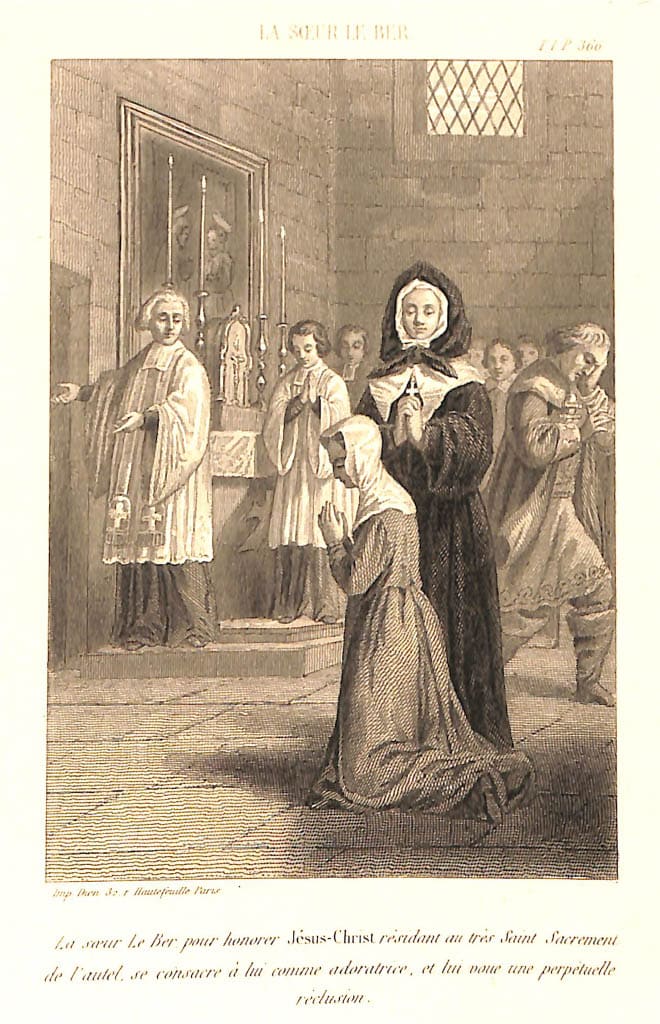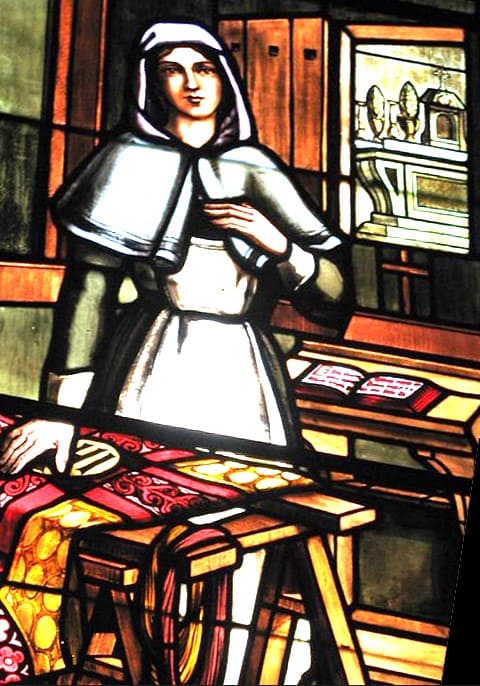Manuscript 1216 of the Archives of Saint Sulpice in Paris
 Engraving illustrating Jeanne’s entrance into seclusion in 1695 The life of Mademoiselle Jeanne Leber, preserved in the Archives of Saint Sulpice in Paris, manuscript 1216, was composed by Étienne Montgolfier in 1779. A priest of Saint Sulpice, he dedicated himself in 1751 to the Sulpician mission in Montreal, of which he was named superior in 1759. The Sulpicians being lords of the island, this appointment made Montgolfier the parish priest of Montreal, the Vicar General of the Bishop of Quebec, the ecclesiastical superior of the religious congregations in his domain (Hospitallers of Saint Joseph, Congregation of Notre Dame, Grey Nuns), and finally the administrator of the Sulpician seigneury. Coinciding with the conquest of Canada by the British Crown, Étienne Montgolfier administered the diocese in a difficult political and religious context before the arrival of Bishop Jean-Olivier Briand, whom he supported as best he could, in his capacity as Vicar General, until his resignation as Superior of Saint Sulpice in Montreal in 1789.
Engraving illustrating Jeanne’s entrance into seclusion in 1695 The life of Mademoiselle Jeanne Leber, preserved in the Archives of Saint Sulpice in Paris, manuscript 1216, was composed by Étienne Montgolfier in 1779. A priest of Saint Sulpice, he dedicated himself in 1751 to the Sulpician mission in Montreal, of which he was named superior in 1759. The Sulpicians being lords of the island, this appointment made Montgolfier the parish priest of Montreal, the Vicar General of the Bishop of Quebec, the ecclesiastical superior of the religious congregations in his domain (Hospitallers of Saint Joseph, Congregation of Notre Dame, Grey Nuns), and finally the administrator of the Sulpician seigneury. Coinciding with the conquest of Canada by the British Crown, Étienne Montgolfier administered the diocese in a difficult political and religious context before the arrival of Bishop Jean-Olivier Briand, whom he supported as best he could, in his capacity as Vicar General, until his resignation as Superior of Saint Sulpice in Montreal in 1789.
The devastating fire at the mother house of the Congregation of Notre Dame, which occurred in 1768, led him to reconstitute their archives based on those of the Seminary of Saint Sulpice in Montreal. Thus, he composed this Life of Jeanne Le Ber based on the testimonies of several nuns who had personally known her.
Preserved in the Archives of Saint Sulpice in Paris under inventory number 1216, the Life of Mademoiselle Jeanne Leber constitutes one of the principal sources on the life of this recluse. It must be supplemented by the biography that the Sulpician François Vachon de Belmont wrote in 1720 shortly after her death in 1714. Manuscript 1232 is also kept in the Archives of Saint Sulpice in Paris (inventory number 1232).
Résumé of Jeanne Le Ber’s Life
Jeanne Le Ber was one of the great religious figures of early New France (Canada).
The second child and only daughter of Jacques Le Ber, a great merchant in Canada, and Jeanne Le Moyne, sister of the Baron de Longueil, Jeanne was born in Ville-Marie (Montreal) on January 4, 1662. The first governor of Montreal, Monsieur Paul de Chomedy de Maisonneuve, was her godfather, and Jeanne Mance was her godmother when her parents had her baptized on the day of her birth by Gabriel Souart, a priest of Saint Sulpice.
Montreal was then a small colony on the alert, threatened by regular incursions since its foundation in 1642. French missionaries tried to prosper in this distant land in order to spread the gospel among the native populations.
At the age of 12, Jacques Le Ber decided to entrust his daughter's education to the Ursuline Sisters in Quebec City where she met her aunt, known as Marie of the Annunciation, who was involved in the education of young boarders at the Ursuline convent. Jeanne Le Ber spent three years there as a boarder, from 1674 to 1677. It was there that she learned the art of embroidery, which made her famous for the large number of altar cloths she made throughout her life. She was only 15 years old when she returned to her family in Montreal. From then on, her parents forced her to dress according to her social status, in order to find her an advantageous match in this mission land.
This stance did not take into account the intimate and profound vow that Jeanne had formed internally by choosing to renounce the world. Her desire to fulfill this vow turned her first to the nuns of the Hôtel-Dieu (Hospital) and then to the Congregation of Notre Dame, where she befriended Sister Marguerite Bourgeoys, who was the principal figure. However, not feeling called to community life, Jeanne Le Ber committed herself to a life of recollection within the family home, thus thwarting the plans that her pious parents had formed for her.
In 1679, Jeanne Le Ber took as her confessor Father François Seguenot, a Sulpician and parish priest of Pointe-aux-Trembles (Montreal). On his advice, Jeanne decided to live a recluse’s life for five years. So, with the permission of her parents, she retired to a cell located behind the chapel of the Hôtel-Dieu de Montréal, founded by Jeanne Mance. It was at that time used as the parish church. There she multiplied acts of mortification, even wearing a hair-shirt under her clothes. She took a vow of silence, refusing to talk to her family and friends. It is said that she even flogged herself as a form of mortification. Jeanne only left her seclusion to attend daily Mass.
On June 24, 1685, she renewed her vows of reclusion, chastity, and poverty. Her spiritual directors, the Sulpician priests, François Dollier de Casson and François Seguenot, encouraged her to follow this path. Her life of poverty and seclusion did not prevent her from keeping her cousin Anna Barroy with her throughout her years. Anna took care of her material needs while accompanying her to Mass, as was appropriate for a person of her rank. She did not refrain from taking care of her business affairs either, not feeling obliged by her vows to dispose of her possessions. Thus, she gave the farm at Point Saint-Charles to the General Hospital of the Charon brothers in Montreal. Her spiritual directors could, moreover, suspend her self-imposed rule of silence, and it does not seem that she was refused permission to receive visitors when she wished.
 Jeanne Le Ber in her hermitage – Stained glass window in the Basilica of Notre Dame in Montréal When the sisters of the Congregation of Notre Dame planned to build a church on their property, Jeanne made a generous gift to them so that a cell could be reserved just behind the altar from which she could see the Blessed Sacrament, without having to leave her place of seclusion. The dwelling, built according to her instructions, had three rooms on top of each other. On the first floor, there was a sacristy where she went to confession and received communion. Also on the first floor, there was a very simple bedroom; and above that, a workshop where she went to do her needlework. From the sacristy, a door opened onto the nuns’ garden. Dollier de Casson signed as a witness the contract that was made before the notary, M. Basset, according to which the Sisters of the Congregation undertook to provide her with clothing, food and firewood, to offer prayers for her every day, and to serve her in the absence of her cousin. In return, Jeanne Le Ber donated the funds necessary to build and decorate the church of the Sisters of the Congregation of Notre Dame. Jeanne also agreed to pay them an annual annuity of 75 ecus.
Jeanne Le Ber in her hermitage – Stained glass window in the Basilica of Notre Dame in Montréal When the sisters of the Congregation of Notre Dame planned to build a church on their property, Jeanne made a generous gift to them so that a cell could be reserved just behind the altar from which she could see the Blessed Sacrament, without having to leave her place of seclusion. The dwelling, built according to her instructions, had three rooms on top of each other. On the first floor, there was a sacristy where she went to confession and received communion. Also on the first floor, there was a very simple bedroom; and above that, a workshop where she went to do her needlework. From the sacristy, a door opened onto the nuns’ garden. Dollier de Casson signed as a witness the contract that was made before the notary, M. Basset, according to which the Sisters of the Congregation undertook to provide her with clothing, food and firewood, to offer prayers for her every day, and to serve her in the absence of her cousin. In return, Jeanne Le Ber donated the funds necessary to build and decorate the church of the Sisters of the Congregation of Notre Dame. Jeanne also agreed to pay them an annual annuity of 75 ecus.
Thus, the heiress and goddaughter of the founders of Montreal, formerly known as Ville-Marie, chose reclusion as the path for her journey to God, by deciding to cloister herself completely in 1695 in the hermitage (“reclusoir”) she had built—with the money initially provided by her father for her dowry—behind the chapel of the boarding school of the Congregation of Notre Dame.
Jeanne took her solemn vows of reclusion on August 5, 1695, in a ceremony attended by Marguerite Bourgeoys herself.
Jeanne devoted much of her time to embroidery and the making of church vestments and altar linens, spending six or seven hours a day in prayer and meditation, and receiving communion four times a week.
It was she who instituted perpetual adoration of the Blessed Sacrament among the nuns of the Congregation of Notre Dame. In order to achieve this goal, she gave this Congregation several substantial donations. She also provided them with the liturgical furnishings necessary for the perpetual celebration of the Holy Sacrifice of Jesus: tabernacle, ciborium, chalice, and monstrance, as well as a silver lamp for the chapel.
Jeanne Le Ber, who was well known in the colony, continued to receive visitors from time to time. Her father visited her twice a year and asked to be buried in the church of the Congregational Sisters to remain close to his venerable daughter beyond death.
In September 1714, Jeanne became seriously ill with a disease that would soon take her away. She therefore decided to dispose of the rest of her possessions by bequeathing to the nuns of the Congregation all her furniture, as well as the sum of 18,000 ecus, the income from which was to be used for the maintenance of seven boarders, before she breathed her last on the morning of October 3. She was buried next to her father near her hermitage.
Her remains now rest in the Notre-Dame-de-Bon-Secours chapel in Montreal, where the remains of Saint Marguerite Bourgeoys are also located.
The Cause of Jeanne Le Ber
More than 300 years after the death of this saintly recluse, the Church of Montreal has never forgotten her. Archbishop Christian Lépine opened the diocesan process for the beatification of Jeanne Le Ber on October 28, 2015, after first obtaining the nihil obstat from the Congregation for the Causes of Saints in Rome.
Saint Sulpice and the Sulpicians of Montreal hold close to their heart the memory of this soul dedicated entirely to God.
Mr. Zakaria HILAL is the archivist of the Society of the Priests of Saint Sulpice in Paris
Translator : Very Rev. Father Ronald D. Witherup



